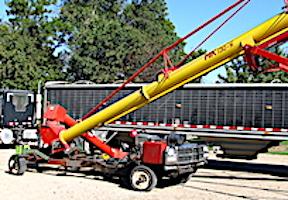
Ray Swenson raises foundation, registered and certified wheat and also operates a certified seed cleaning operation, so he moves a lot grain into bins with big augers. He says his self-propelled grain auger - built out of an old Dodge 4-WD pickup - makes the job a lot easier.
He uses the rig to move and operate a 91-ft. long, 13-in. dia. Westfield swing away auger, which is bolted to a big steel frame welded to the pickup’s frame.
“I built it 3 years ago and we use it all year long. It eliminates the need to hook up a tractor to an auger and almost makes loading bins a fun job,” says Swenson. “I can move quickly from bin to bin and place the auger into position with no problem. With no tractor in the way, the swing away auger has a full 360 degree range for convenience in positioning the truck for dumping.
“I came up with the idea because I’m 86 and have a neck injury, and it was painful looking over my shoulder while trying to back up a tractor to position the auger. Also, I didn’t enjoy unloading trucks out in the dust and hot sun during harvest.”
Since Swenson raises certified seed, he has to reverse the auger for cleaning between seed lots. “Most tractors don’t have a reversing pto, but with my self-propelled auger I can just shift the pickup’s automatic transmission into reverse to reverse the auger flighting.”
He started with a 1992 Dodge W250 4-WD pickup equipped with a Cummins diesel engine and automatic transmission. He stripped the pickup down to the front wheels and axle, engine, transmission, and frame which he welded to another frame off a Melroe chisel plow. A pair of caster wheels off an Oliver chisel plow support the bottom end of the auger.
He removed the pickup’s rear axle and uses the driveshaft to power a 5-speed transmission off an old Ford truck. The transmission shaft-drives a gearbox (off a Steiger Bearcat tractor) that’s mounted on back of the rig. The gearbox is equipped with a forward facing pto shaft with the correct rotation to power the auger.
“The auger is fastened to a hitch, and the pto attached as it would be on a tractor and with the usual hydraulic hoses and so forth. That way I can replace the auger if needed,” says Swenson.
“On this Dodge pickup model the front axle is engaged manually, so I disengage the front axle and shift the 5-speed transmission into gear to power the auger as if I’m in 2-WD. To operate the auger I put the 5-speed transmission in second gear, which runs the auger at just the right speed. To move the rig, I shift the transmission into neutral and engage the front axle.
He mounted a remote throttle on the auger tube that lets him start and stop the auger automatically. “To unload a truck (front axle neutral) I place the automatic transmission in ‘drive’ with the pickup engine idling (like waiting at a stoplight). Once the grain starts flowing (stoplight turns green) I start throttling up and the automatic transmission shifts into first, second, and third gear until the auger is unloading full bore,” says Swenson.
“When the truck starts to run empty, I throttle down and the automatic transmission drops back into first gear, with the auger quietly idling again.”
The caster wheels make the rig easy to steer. “I built a telescoping ‘A’ frame hitch from the main axle of the auger back to the front axle of the pickup, which becomes the steering axle. The caster wheels follow along as I turn,” says Swenson.
The self-propelled auger is still a work in progress. “Since the photos were taken we’ve added a sun shade equipped with a couple fans, a remote controlled electric Auger-Jogger to move the swing away hopper into place, and a hydraulic winch to lift it,” he notes.
Contact: FARM SHOW Followup, Ray Swenson, Swenson Feed Farm, 29667 State Hwy. 92 S.E., Brooks, Minn. 56715 (cell ph 218 280-1934; swenseed@gvtel.com).
